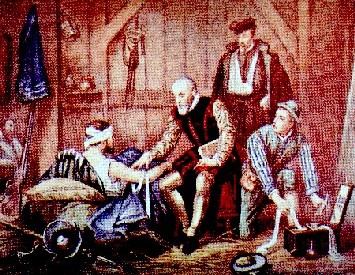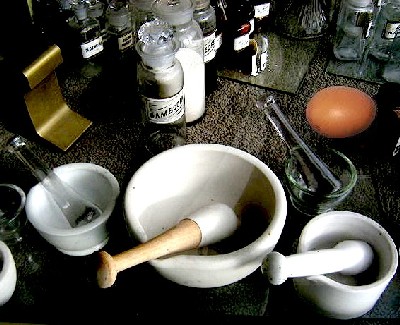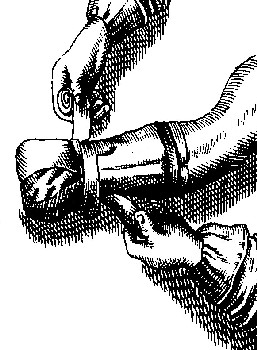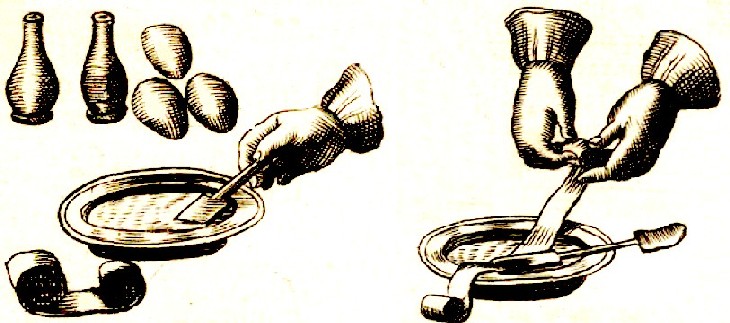
Eggs and Medicine: 1 2 3 4 <<Prev
Eggs in Medicine During the Golden Age of Piracy, Page 4
Eggs In Illness: As Ingredients in Medicine
Eggs had another use to the period surgeon as an ingredient in medicines. Like the clysters described previously, eggs were added to various medical prescriptions. Their primary use was as an emollient - something that softened the skin and encouraged healing while preventing scarring.

Ambroise Paré Bandaging the Wounded by Eduoard Hamman
Eggs use in healing wounds was brought to the fore by Ambroise Paré when he was treating gunshot wounds in the early 16th century. The general procedure at the time was to cauterize [burn] gunshot wound because they were thought to be poisonous (see the article on curing bullet wounds to learn more about this.) Paré found he had run out of "seething elder oil"1, so he decided "to apply a digestive [substance to promote healthy flesh formation in a wound] of yolkes of egges, oyle of Roses, and Turpentine. In the night I could not sleepe in quiet, fearing some default in not cauterizing".2 Anxiously checking on his patients the next morning, he noticed that not only did his simple concoction work - it worked better than cauterization! This discovery would alter the treatment of wounds for centuries to come, sparking a debate about the efficacy of cauterization to stop bleeding.

A ship explosively afire during battle,
Artist and title unknown, 18th century
Eggs were often used in the cure of burns as well. Being composed primarily of wood, having decks caulked with flammable tar and rope and rigged with multiple canvas sails, fire on ships was a tremendous danger. During battle, it would be easy for the black powder loaded by hand into weapons to be spilled upon the deck with the weapons spitting sparks when fired. In addition, the enemy knew the dangers of fire and could use this knowledge to try and gain the upper hand by trying to set the ship and its sails alight .
To heal burns John Woodall suggested "Oyle of Roses, or Oyle of Eggs [extracted from the yolk of an egg], or of Roses mixt with the white of an egge".3 Richard Wiseman specified that the egg be used in "the Parts deeper burnt [after they] threw off their Eschars [dead tissue]" explaining that "I digested them with Yolk of an egg and a little terebinth. lot. in aq. solani [bittersweet water - made from Solanum dulcamara]."4 Stephen Bradwell gives us a full accounting of how to use eggs for a burn. "Take the White of an egge or two or more of them, according to the largenesse of the hurt: Beat it with a sufficient quantitie of oyle of Roses, or els of sallet oyle [oil and vinegar]. Dip fine rags in it, and apply them to the place, and take them off no more till it be well. Onely three or foure times in a day wet the place through them with the sayd mixture."5

In addition to burns, eggs were used to heal wounds and ulcers. Given their emollient nature, this seems logical. On the subject of treating wounds, Ambroise Paré said, "Hither tend proper and fit
medicines, to wit, applying of oyle of Roses with the whites of Egges, and the like repelling things".6 Repelling medicines were those that defended against (or repelled) bad humors. Richard Wiseman advised "...in greater Wounds that will not so easily be cured, we stitch the Lips [of the wound] together, and sprinkle them with such like Powder with the White of an egg over them, with a Compress prest out of Oxycrate [an astringent mixture of water and vinegar], and a suitable Bandage over all."7 Wiseman also noted that "...in Fractures with great Contusion [wounds], or [fractures] in and near the Joints, I have continued the use of Compresses wet in Whites of Eggs during the whole Cure with
good success."8
Along similar lines, John Atkins suggested using eggs when making "Fistula Tents [which are] are down of Lint beat up with White of Egg, and dry"d on a smooth Board, cutting them out afterwards, and arming with that Medicine you please."9 These pieces of folded, medicated cloth were inserted into deep wounds to allow the excape of bad humors [represented by pus] so that the wound could heal. Or so many of the surgeons thought at this time; today we recognize pus formation as a sign of infection.

Bandaging an amputated limb, taken from
The Chyrurgeons Storehouse, by
Johannes Scultetus, p. 44 (1653)
Surgeons also made use of eggs when medicating the stump and the bandages applied to it following an amputation. Sea surgeon John Moyle advises the reader to "[t]ake fine Tow, and make even and round Pledgits [cloth bandages] of it, about the
wideness of an amputated Stump, (some larger and some narrower) and lay it on a smooth board; then take whites of Eggs beaten and mixt with Vinegar, and sprinkle your Pledgits till they are thoroughly wet, then place another smooth board a top of them to press them hard; let it lye on a certain space, then take them and let them be dryed in the Sun, or before a warm Fire".10 This bandage was then to be applied directly to the amputated area.
John Woodall similarly calls for restrictives made with vinegar "and the white and yolke of an egge together mixt if it may well be had"11 to be "laid on the great ends of the Vaines and Arteries when they are absized".12 Notice Woodall's comment that eggs should be used when they were well had - an interesting comment indicating that would probably not be always available even to the surgeon. Woodall later calls for "a good digestive of Terebinthine [spirit of turpentine] and the yolke of an egge".13 Other period surgeons list eggs to be used in a similar manner during amputation.14 For more on amputation and it's medicines, see Amputation During the Golden Age of Piracy.
You may have noticed by now that eggs were often mixed with other things in medicinal concoctions. The above examples often refer to eggs being mixed with vinegar and Oil of Roses [Roses were thought to have binding and astringent qualites.15] Presumably this was because the eggs' emollient qualities would soften the skin making it more accepting of the medicines applied with them.

Eggs combined with red wine and rose oile and applied to bandages, taken from The Chyrurgeons Storehouse,
by Johannes Scultetus, p. 105 (1653)
Other cures specified medicines combined with eggs. For pimples caused by swelling in gonorrhea, John Moyle recommended "Unguentum alb. Camph. [Camphor and egg white unguent]"16. When trepanning (drilling holes in the skull), John Woodall suggested that "the place hurt being well clensed, poure mel rosarum warme into the wound, or two parts of Hony, and one part of oyle or syrupe of drie Roses, or common Honey with Terpintine, with the yolke of an egge, which are remedies mundifying, and gratefull to the Membrans, and ought to be applied warme".17
1 Ambroise Paré, The Apologie and Treatise of Ambroise Paré, p. 23; 2 Paré, p. 23-4; 3 John Woodall, the surgion's mate, p. 146; 4 Richard Wiseman, Of Wounds, Severall Chirurgicall Treatises, p. 442; 5 Stephen Bradwell, Helps For Suddain Accidents Endangering Life, p. 120; 6 Paré, p. 169); 7 Wiseman, p. 348; 8 Ibid, p. 468-9; 9 John Atkins, The Navy Surgeon, p. 74-5; 10 John Moyle, The Sea Chirurgeon, p. 45; 11 Woodall, p. 172; 12 Ibid, p. 173; 13 Ibid. p. 176; 14 Wiseman, p. 455 & Atkins, p. 118; 14 Nicholas Culpepper, The English Physitian Enlarged, 1666, p. 205; 16 Moyle, p. 140; 17 Woodall, p. 135

